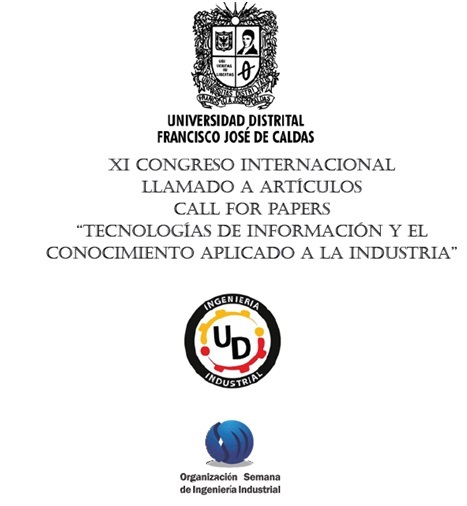DOI:
https://doi.org/10.14483/2248762X.8507Publicado:
2015-09-04Edição:
v. 6 (2015)Seção:
ReflexiónLAS ORGANIZACIONES SENSIBLES, COHERENTES Y LUCIDAS (OSCL): SU INTEGRIDAD Y ESTRUCTURA COGNITIVA – VALORATIVA
Downloads
Resumo (es)
Una empresa que adopta la gestión del conocimiento en su modelo OSCL garantiza que gana en identidad y en arquitectura empresarial mediante la conducción del flujo organizacional en estados de perturbación o turbulencia, logrando arquetipos de labor disciplinada en estados de movilidad estática o dinámica y orden simple o complejo desde los cuales se valora direcciona y conduce la empresa hacia la cultura del éxito desde el desarrollo de los sujetos hacia y en el desarrollo empresarial impactando y estimulando el desarrollo social
Referências
Akgun, A., Byrne, J., Lynn, G., & Keskin, H. (2007). New Product development in turbulent environments: Impact of improvisation and unlearning on new product performance. Journal of Engineering and technology Management, 24, 203-230.
Aldrich, H. (1979). Organizations and environments. Prentice - Hall.
Anderson, C., Paine, F. (1975). Managerial Perceptions and Strategic Behavior. The Academy of Management Journal, 18 (4), 811-823.
Ansoff, I., Eppink, J., & Gomer, H. (1979). Management of Strategic surprise and discontinuity: problem of managerial decisiveness
Ansoff, Igor [1993]. El planeamiento Estratégico. Nueva tendencia de la Administración. / H Ansoff, R. P. Declerk y Hayes R.I. / Editorial Trillas, México
Barnett, W. & Carroll, G. (1995). Modeling Internal Organizational Change. Annual Review of Sociology, 21, 217-236.
Becherer, R. & Maurer, J. (1998). The moderating effect of environmental variables on the entrepreneurial and marketing orientation of entrepreneur-led firms, Entrepreneurship Theory and Practice, 22(1): 47-58.
Bennis, W. (1966). Changing organizations: Essays on the development and evolution of human organization. New York: McGraw Hill.
Bourgeois III, L. J. (1985). Strategic Goals, Perceived Uncertainty and Economic Performance In Volatile Environments. Academy of Management Journal, 28(3), 548-573. Retrieved from EBSCO host.
Calantone, R., Garcia, R. & Droge, C. (2003). The Effects of Environmental Turbulence on New product Development Strategy Planning. Journal of product Innovation Management, 20, 90-103.
Collins y Porras. Empresas que perduran. Editorial Norma.
Coutnhbey, H. (2001). 20/20 foresight: crafting strategy in an uncertain world Boston, Mass. Harvard Business School Press.
Dess & Beard, D. (1984). Dimensions of organizational task environments. Administrative Science Quarterly, 52-73.
Dess, G. G., & Beard, D. W. (1984). Dimensions of Organizational Task Environments. Administrative Science Quarterly, 29(1), 52-73. Retrieved from EBSCOhost.
Dess, G., Lumpkin, G. & Covin, J. (1997). Entrepreneurial strategy making and firm performance: tests of contingency and configurational models. Strategic Management Journal, vol. 18(9): 677-695.
Duncan, R. B. (1972). Characteristics of Organizational Environments and Perceived Environmental Uncertainty. Administrative Science Quarterly, 17(3), 313-327.
Duncan Robert M. (1992), “Quality Forecasting Drives Quality Inventory at GE Silicones,” Industrial Engineering, January, pp. 18-21
Emery, F. & Trist, E. (1965). The Causal Texture of Organizational Environments. Human Relations, 18 (21), 21-32.
Ferber, J (1999) Multi-Agent Systems: An Introduction to Distributed Artificial Intelligence. Addison Wesley
Gray, Ann E., Abrahan Seidmann, and Kathryn –e. Stecke (1993), “A Synthesis of Decision Models for Tool Management in Automated Manufacturing,” Management Science, vol. 39, no. 5, May, pp. 549-564.
Georgoff, D.M., and R. G: Murdick (1986), “Manager´s Guide to Forecasting,” Harvard Business Review, January – February, pp. 110-120.
Heisig, P., Vorbeck, J. (2001): Benchmarking Survey Results. In: Mertins, K., Heisig, P., Vorbeck, J. (Eds.): Knowledge Management. Best Practice in Europe. Berlin, Heidelberg: Springer-Verlag, 1st. Ed., p. 97-123
Kauffman, S. (1993) The Origins of Order: Self Organization and Selection in Evolution. Oxford University Press
Mainzer, K. (1996) Thinking in Complexity: the Complex Dynamics of Matter, Mind and Mankind. Second Edition, Springer
Maruyama, M. (1963) The second cybernetics: Deviation-amplifying mutual causal processes’ American Scientist, 51: 164–79
Maturana, H. & Varela, F. (1992) The Tree of Knowledge. Shambhala
Maturana, H. (1997) Workshop at the Open University, March
Milliken, F. J. (1987). Three Types of Perceived Uncertainty About the Environment: State, Effect, and Response Uncertainty. Academy of Management Review, 12(1), 133-143.
Meza J.J, Bejarano Lilian (2000). Realización de proyectos de vida en las organizaciones sensibles coherentes y lucidas. Revista Ingeniería Universidad Distrital Francisco José de Caldas. 5(1). 82-86
Mitleton, K. E. (2003). Ten principles of complexity & Enabling Infrastructures. In Complex systems and evolutionary perspectives of organizations: The application of complexity theory to organizations. London: London School Economics.
Probst, G.J.B. (2002): Putting knowledge to work: Case-writing as a knowledge management and organizational learning tool. In: Davenport, Th.; Probst, G.J.B. (Eds.): Knowledge Management Case Book. Best Practices. Erlangen: Publicis and Wiley, 2nd. Edition, p. 312-323
Sallenave, J. P. (2002). La gerencia Integral: No le tema a la competencia, témale a la incompetencia. Ed. Norma.
Serrano González J. Manuel, Carranza Carnicero José Antonio Brito De La Nuez Alfredo Gustavo. Los componentes básicos del equilibrio cognitivo y las formas posibles de equilibración cognitiva según la Escuela de Ginebra Anales Psicología N.O 3, 1986 Págs. 109-127
Strategic Goals, Perceived Uncertainty, And Economic Performance in Volatile Environments 1975 "Guidehnes for the empirical classification of organizations."
Volberda, H. W. (1997). Building flexible organizations for fast-moving markets. Long Range Planning, 30 (2), 169-183.
Scott, W. Richard (1981) Organizations: Rational, Natural, and Open Systems. Englewood Cliffs, NJ: Prentice- Hall,
Robert Storey 1973 "On the measurement of the environment: An assessment of the Lawrence and Lorsch environmental uncertainty questionnaire," Administrative Science Ouarteriy, 18: 27-36.
Tung, Rosalie L. 1979 "Dimensions of organizational environments: An exploratory study of their impact on organization structure," Academy of Management Journal, 22:672-693
Como Citar
APA
ACM
ACS
ABNT
Chicago
Harvard
IEEE
MLA
Turabian
Vancouver
Baixar Citação
Licença
Reconocimiento – NoComercial – CompartirIgual (by-nc-sa): No se permite el uso comercial de la obra original, las obras derivadas deben circular con las mismas condiciones de esta licencia realizando la correcta atribución al autor.
Esta obra está bajo una licencia de Creative Commons Reconocimiento-NoComercial-CompartirIgual 4.0 Internacional













